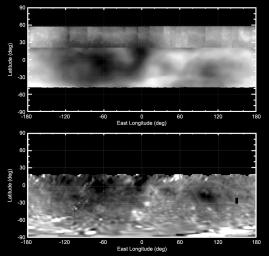
|
Two Views of Vesta Bright and Dark
- Click the image above for a larger view
- Full-Res JPEG (1008 x 958) (89.5 kB)
- Full-Res TIFF (1008 x 958) (966.8 kB)
Caption:
These two maps of the giant asteroid Vesta show patterns of brightness from NASA's Hubble Space Telescope (top) and NASA's Dawn spacecraft (bottom). Hubble's view is from an orbit around Earth. Dawn went into orbit around Vesta from 2011 to 2012. Scientists have been able to correlate several bright and dark features originally identified in Hubble images with features imaged at high resolution by the Dawn spacecraft's framing camera.
Background Info:
The Dawn mission to Vesta and Ceres is managed by NASA's Jet Propulsion Laboratory, a division of the California Institute of Technology in Pasadena, for NASA's Science Mission Directorate, Washington. The University of California, Los Angeles, is responsible for overall Dawn mission science. The Dawn framing cameras were developed and built under the leadership of the Max Planck Institute for Solar System Research, Katlenburg-Lindau, Germany, with significant contributions by DLR German Aerospace Center, Institute of Planetary Research, Berlin, and in coordination with the Institute of Computer and Communication Network Engineering, Braunschweig. The framing camera project is funded by the Max Planck Society, DLR and NASA.
More information about Dawn is online at http://www.nasa.gov/dawn and http://dawn.jpl.nasa.gov .
Cataloging Keywords:
| Name | Value | Additional Values |
|---|---|---|
| Target | 4 Vesta | |
| System | Main Belt | |
| Target Type | Asteroid | |
| Mission | Dawn | Hubble Space Telescope (HST) |
| Instrument Host | Dawn | Hubble Space Telescope |
| Host Type | Orbiter | Space Telescope |
| Instrument | Framing Camera (FC) | |
| Detector | ||
| Extra Keywords | Grayscale | |
| Acquisition Date | ||
| Release Date | 2013-09-27 | |
| Date in Caption | ||
| Image Credit | NASA/ESA/PSI/MIT and NASA/JPL-Caltech/UCLA/MPS/DLR/IDA | |
| Source | photojournal.jpl.nasa.gov/catalog/PIA17465 | |
| Identifier | PIA17465 | |
